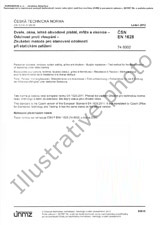We need your consent to use the individual data so that you can see information about your interests, among other things. Click "OK" to give your consent.

ČSN EN 61937-4 (367552)
Digital audio - Interface for non-linear PCM encoded audio bitstreams applying IEC 60958 - Part 4: Non-linear PCM bitstreams according to the MPEG audio format
STANDARD published on 1.12.2003
The information about the standard:
Designation standards: ČSN EN 61937-4
Classification mark: 367552
Catalog number: 68931
Publication date standards: 1.12.2003
SKU: NS-161330
The number of pages: 20
Approximate weight : 60 g (0.13 lbs)
Country: Czech technical standard
Category: Technical standards ČSN
The category - similar standards:
Annotation of standard text ČSN EN 61937-4 (367552):
Tato norma se vztahuje na digitální rozhraní pro přenos zvukového bitového toku. Specifikuje digitální zvukové rozhraní podle IEC 60958 pro přenos digitálního signálu přenášeného nelineární PCM ve formátu MPEG audio.
These corrections apply to this standard:
Digitální zvuk - Rozhraní pro zvukový bitový tok kódovaný nelineární PCM používající IEC 60958 - Část 4: Nelineární bitový tok PCM podle formátu MPEG audio. (Norma přebírající anglický originál, vlastní text je součástí výtisku).
Correction published on 1.7.2004
Selected format:Show all technical information.
Similar standards:
1.4.2006
1.12.2007
WITHDRAWN
1.6.2008
WITHDRAWN
1.12.2011
WITHDRAWN
1.1.2011
1.1.2011
We recommend:
Technical standards updating
Do you want to make sure you use only the valid technical standards?
We can offer you a solution which will provide you a monthly overview concerning the updating of standards which you use.
Would you like to know more? Look at this page.



 Cookies
Cookies
